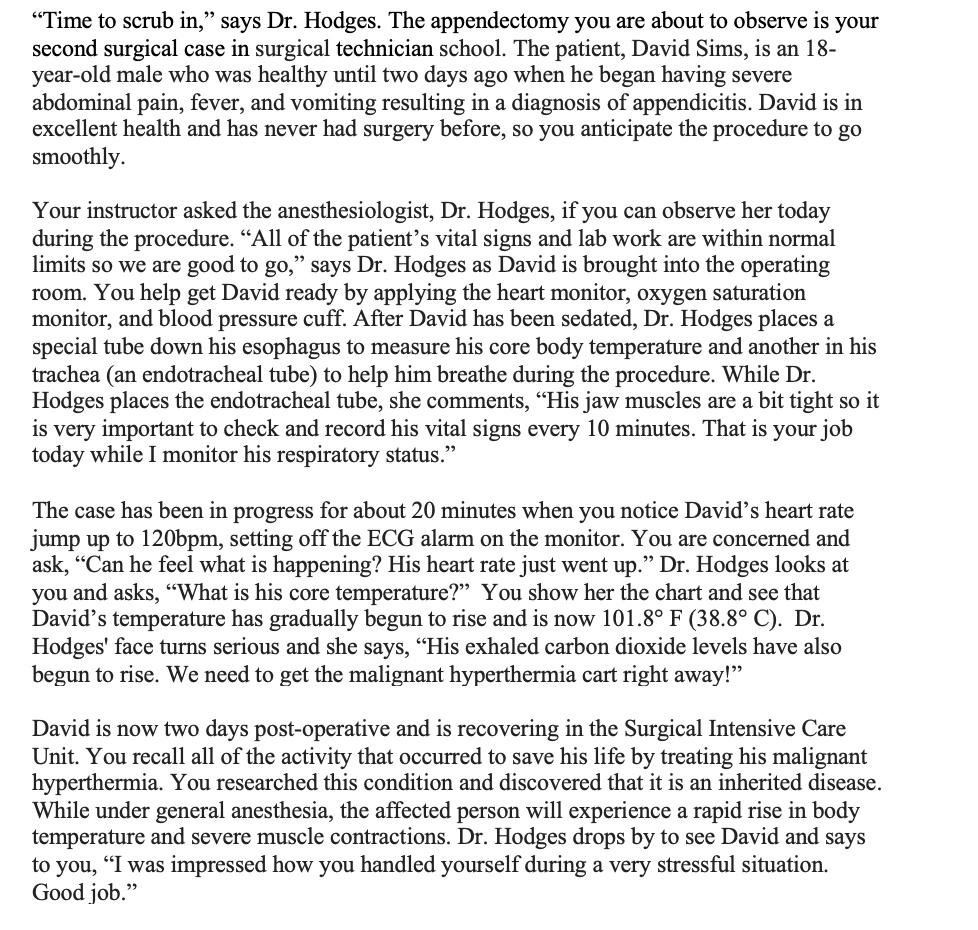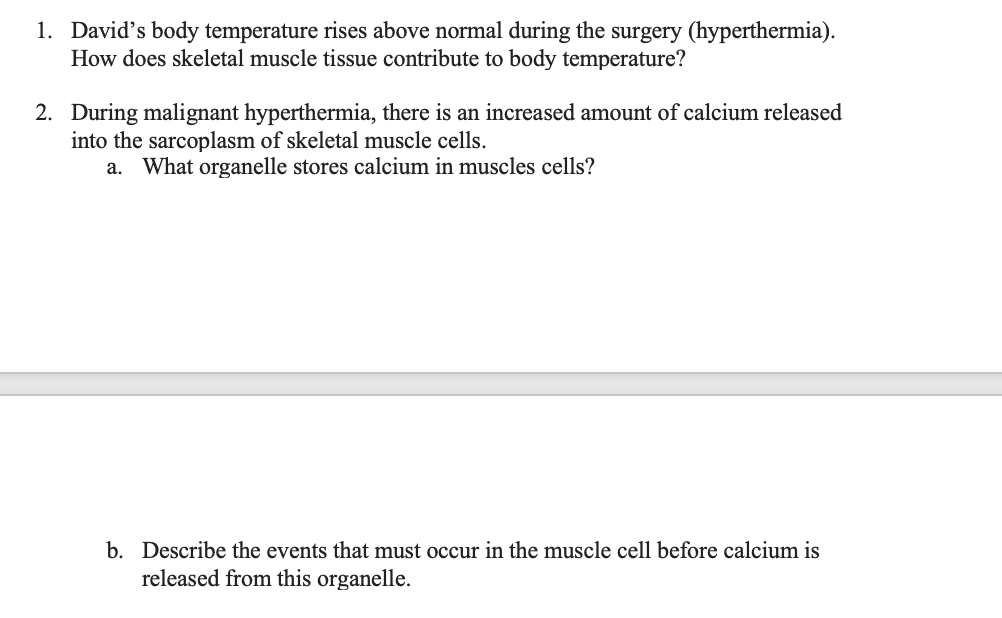1. David's body temperature rises above normal during the surgery (hyperthermia). How does skeletal muscle tissue contribute to body temperature? 2. During malignant hyperthermia, there is an increased amount of calcium released into the sarcoplasm of skeletal muscle cells. a. What organelle stores calcium in muscles cells? b. Describe the events that must occur in the muscle cell before calcium is released from this organelle.
1. David's body temperature rises above normal during the surgery (hyperthermia). How does skeletal muscle tissue contribute to body temperature? 2. During malignant hyperthermia, there is an increased amount of calcium released into the sarcoplasm of skeletal muscle cells. a. What organelle stores calcium in muscles cells? b. Describe the events that must occur in the muscle cell before calcium is released from this organelle.
Human Anatomy & Physiology (11th Edition)
11th Edition
ISBN:9780134580999
Author:Elaine N. Marieb, Katja N. Hoehn
Publisher:Elaine N. Marieb, Katja N. Hoehn
Chapter1: The Human Body: An Orientation
Section: Chapter Questions
Problem 1RQ: The correct sequence of levels forming the structural hierarchy is A. (a) organ, organ system,...
Related questions
Question

Transcribed Image Text:"Time to scrub in," says Dr. Hodges. The appendectomy you are about to observe is your
second surgical case in surgical technician school. The patient, David Sims, is an 18-
year-old male who was healthy until two days ago when he began having severe
abdominal pain, fever, and vomiting resulting in a diagnosis of appendicitis. David is in
excellent health and has never had surgery before, so you anticipate the procedure to go
smoothly.
Your instructor asked the anesthesiologist, Dr. Hodges, if you can observe her today
during the procedure. "All of the patient's vital signs and lab work are within normal
limits so we are good to go," says Dr. Hodges as David is brought into the operating
room. You help get David ready by applying the heart monitor, oxygen saturation
monitor, and blood pressure cuff. After David has been sedated, Dr. Hodges places a
special tube down his esophagus to measure his core body temperature and another in his
trachea (an endotracheal tube) to help him breathe during the procedure. While Dr.
Hodges places the endotracheal tube, she comments, "His jaw muscles are a bit tight so it
is very important to check and record his vital signs every 10 minutes. That is your job
today while I monitor his respiratory status."
The case has been in progress for about 20 minutes when you notice David's heart rate
jump up to 120bpm, setting off the ECG alarm on the monitor. You are concerned and
ask, "Can he feel what is happening? His heart rate just went up." Dr. Hodges looks at
you and asks, "What is his core temperature?" You show her the chart and see that
David's temperature has gradually begun to rise and is now 101.8° F (38.8° C). Dr.
Hodges' face turns serious and she says, "His exhaled carbon dioxide levels have also
begun to rise. We need to get the malignant hyperthermia cart right away!"
David is now two days post-operative and is recovering in the Surgical Intensive Care
Unit. You recall all of the activity that occurred to save his life by treating his malignant
hyperthermia. You researched this condition and discovered that it is an inherited disease.
While under general anesthesia, the affected person will experience a rapid rise in body
temperature and severe muscle contractions. Dr. Hodges drops by to see David and says
to you, "I was impressed how you handled yourself during a very stressful situation.
Good job."

Transcribed Image Text:1. David's body temperature rises above normal during the surgery (hyperthermia).
How does skeletal muscle tissue contribute to body temperature?
2. During malignant hyperthermia, there is an increased amount of calcium released
into the sarcoplasm of skeletal muscle cells.
a. What organelle stores calcium in muscles cells?
b. Describe the events that must occur in the muscle cell before calcium is
released from this organelle.
Expert Solution
This question has been solved!
Explore an expertly crafted, step-by-step solution for a thorough understanding of key concepts.
This is a popular solution!
Trending now
This is a popular solution!
Step by step
Solved in 4 steps with 1 images

Recommended textbooks for you

Human Anatomy & Physiology (11th Edition)
Anatomy and Physiology
ISBN:
9780134580999
Author:
Elaine N. Marieb, Katja N. Hoehn
Publisher:
PEARSON

Anatomy & Physiology
Anatomy and Physiology
ISBN:
9781259398629
Author:
McKinley, Michael P., O'loughlin, Valerie Dean, Bidle, Theresa Stouter
Publisher:
Mcgraw Hill Education,

Human Anatomy
Anatomy and Physiology
ISBN:
9780135168059
Author:
Marieb, Elaine Nicpon, Brady, Patricia, Mallatt, Jon
Publisher:
Pearson Education, Inc.,

Human Anatomy & Physiology (11th Edition)
Anatomy and Physiology
ISBN:
9780134580999
Author:
Elaine N. Marieb, Katja N. Hoehn
Publisher:
PEARSON

Anatomy & Physiology
Anatomy and Physiology
ISBN:
9781259398629
Author:
McKinley, Michael P., O'loughlin, Valerie Dean, Bidle, Theresa Stouter
Publisher:
Mcgraw Hill Education,

Human Anatomy
Anatomy and Physiology
ISBN:
9780135168059
Author:
Marieb, Elaine Nicpon, Brady, Patricia, Mallatt, Jon
Publisher:
Pearson Education, Inc.,

Anatomy & Physiology: An Integrative Approach
Anatomy and Physiology
ISBN:
9780078024283
Author:
Michael McKinley Dr., Valerie O'Loughlin, Theresa Bidle
Publisher:
McGraw-Hill Education

Human Anatomy & Physiology (Marieb, Human Anatomy…
Anatomy and Physiology
ISBN:
9780321927040
Author:
Elaine N. Marieb, Katja Hoehn
Publisher:
PEARSON